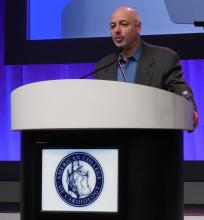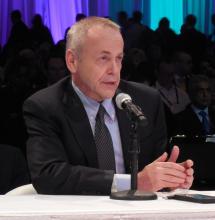ORLANDO – Wearable cardioverter defibrillator vests failed to significantly cut the rate of arrhythmic death in at-risk post-MI patients but succeeded in significantly dropping total mortality during a median of 84 days of use in the first randomized trial of nonimplanted defibrillators in such patients.
Post-MI patients with a left ventricular ejection fraction of 35% or less at baseline who wore the wearable cardioverter defibrillator (WCD) had a statistically significant 36% relative risk reduction in total mortality and an absolute total death reduction of 1.7%, compared with controls, in the first randomized trial to test the efficacy of a WCD, Jeffrey Olgin, MD said at the annual meeting of the American College of Cardiology.But despite this overall mortality benefit, the 1,524 patients randomized to the WCD group failed to show a significant improvement in the rate of sudden and ventricular tachycardia death, the primary endpoint for the study, said Dr. Olgin, chief of cardiology at the University of California, San Francisco. Total mortality was a secondary endpoint in the study. Based on the total mortality benefit observed and the “totality of evidence” from prior, uncontrolled observational studies, Dr. Olgin concluded that it is now “reasonable” to protect post-MI patients with ejection fractions of 35% or less during the first 40-90 days following an MI when patients can then be assessed for receiving an implantable cardioverter defibrillator.
That would be an upgrade from the current American College of Cardiology/American Heart Association guidelines on managing ventricular arrhythmias and preventing sudden cardiac death, issued in 2017, that classified WCDs as a class IIb recommendations – “may be reasonable” – for post-MI patients with a reduced left ventricular ejection fraction (Circulation. 2017 Oct 30;doi:10.1161/CIR.0000000000000549).
WCDs are currently approved for routine prescribing by U.S. physicians, but their use is very variable in post-MI patients. Just before Dr. Olgin delivered his report at the meeting, a poll of the several thousand meeting attendees who heard his talk showed that roughly a third reported routinely prescribing WCDs, with the other two thirds saying they did not.
Several electrophysiologists who heard the report agreed that further research needs to better tease out which post-MI patients get the most benefit from this treatment.
With a cost for a WCD of about $10,000 for about 3 months of treatment it would be better to target a “subgroup at higher risk,” commented David J. Wilber, MD, professor of medicine and director of the Cardiovascular Institute at Loyola University Medical Center in Maywood, Ill.The patients enrolled in the study “were not a sick population; they had a low event rate,” commented Sana M. Al-Khatib, MD, professor of medicine at Duke University in Durham, N.C. and chair of the panel that wrote the 2017 ventricular arrhythmia guidelines. She suggested testing the efficacy of WCDs in post-MI patients with lower ejection fractions or those with a greater history of heart disease prior to their index MI. Nearly half of the patients enrolled in the study had New York Heart Association class I symptoms, indicating that they had mild heart disease, she noted in an interview. Another issue left unresolved by the results Dr. Olgin reported was how much of the mortality benefit was attributable to the shocks delivered by the tested WCDs and how much derived from the arrhythmia monitoring that the WCDs provided.
Dr. Al-Khatib suggested a new study to compare the efficacy of WCDs against management directed by use of an implantable loop recorder.Another way to better target WCDs to post-MI patients who could derive the most benefit might be to focus on patients with frequent premature ventricular contractions and nonsustained ventricular tachycardia, suggested Dhanunjaya Lakkireddy, MD, professor of medicine and director of the Center for Excellence in AF and Complex Arrhythmias at the University of Kansas Medical Center in Kansas City. But Dr. Lakkireddy acknowledged that currently left ventricular ejection fraction is the primary surrogate marker cardiologists rely on to identify post-MI patients who are at increased risk for ventricular arrhythmia.
Dr. Olgin countered that the total mortality rate seen among the control, usual care patients in his study, 4.9% during the median 84 day follow-up, closely matched the 5% rate reported in prior trials of at-risk patients who received implantable cardioverter defibrillators.
The Vest Prevention of Early Sudden Death Trial (VEST) randomized patients within the first 7 days following an acute MI who met the reduced left ventricular ejection fraction criterion. The study ran at 108 sites in the United States and three European countries during 2008-2017.During follow-up, total mortality occurred in 3.1% of the patients randomized to WCD use and 4.9% among the control patients.
The results also showed that 19% of the patients randomized to the WCD arm failed to ever use the device, and that over the course of follow-up the usage rate fell below 50%. Patients who used the device generally wore it as directed, however, with an average 22 hours a day of use at the start of treatment that subsequently dipped to 21 hours a day near the end of the 90-day treatment period, Dr. Olgin reported.
The most likely explanation for the disparity between the significant effect on total mortality and the insignificant effect on arrhythmia mortality is misclassification of some deaths. “Any small number of misclassified sudden deaths would have dramatically reduced our power to see a difference” in arrhythmia deaths, Dr. Olgin noted.
VEST was sponsored by Zoll, the company that markets the tested device. Dr. Olgin has no personal disclosures. Dr. Al-Khatib and Dr. Lakkireddy had no disclosures. Dr. Wilber is a consultant to Biosense Webster and Medtronic.
SOURCE: Olgin J et al. ACC 18.





